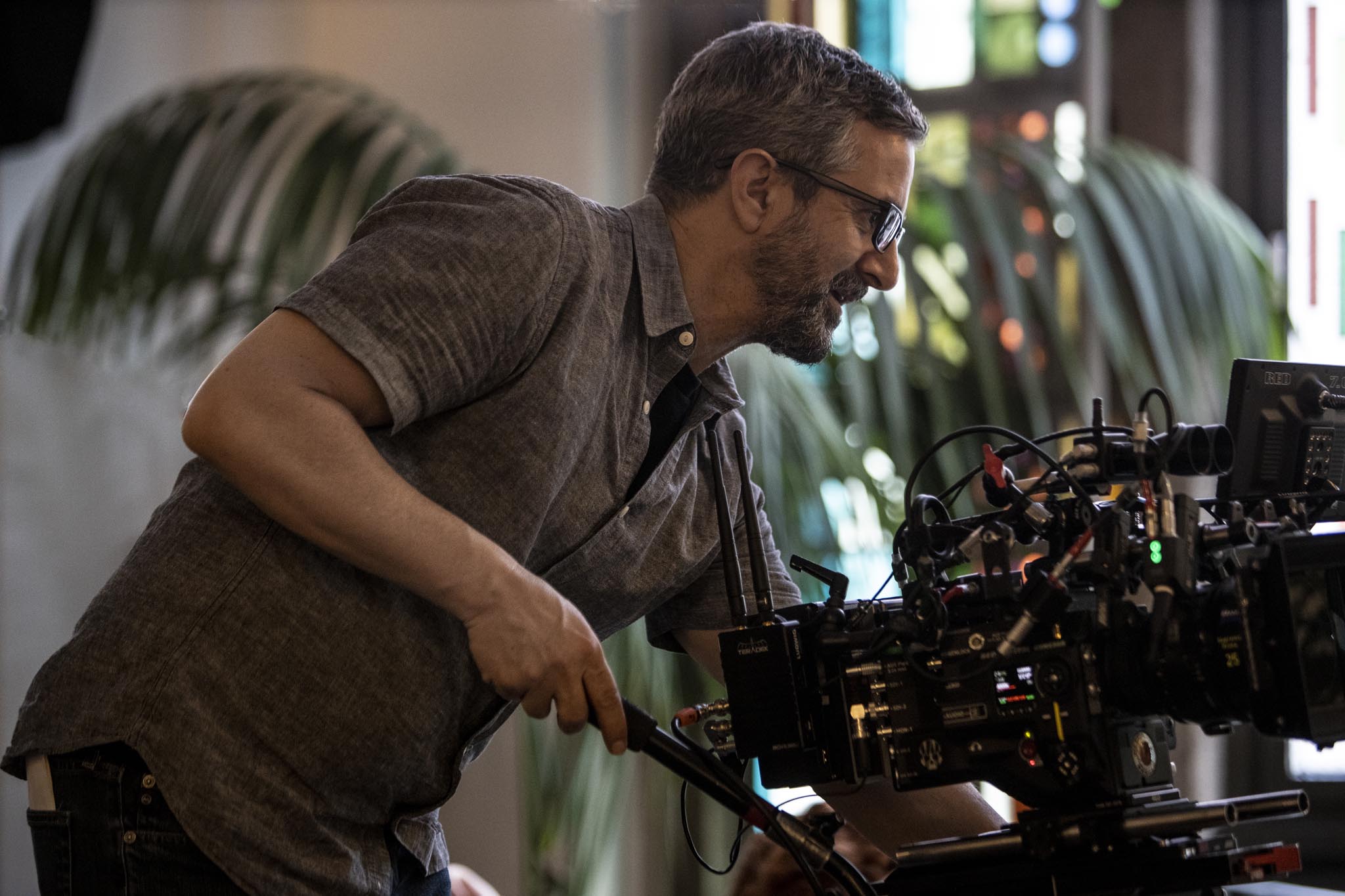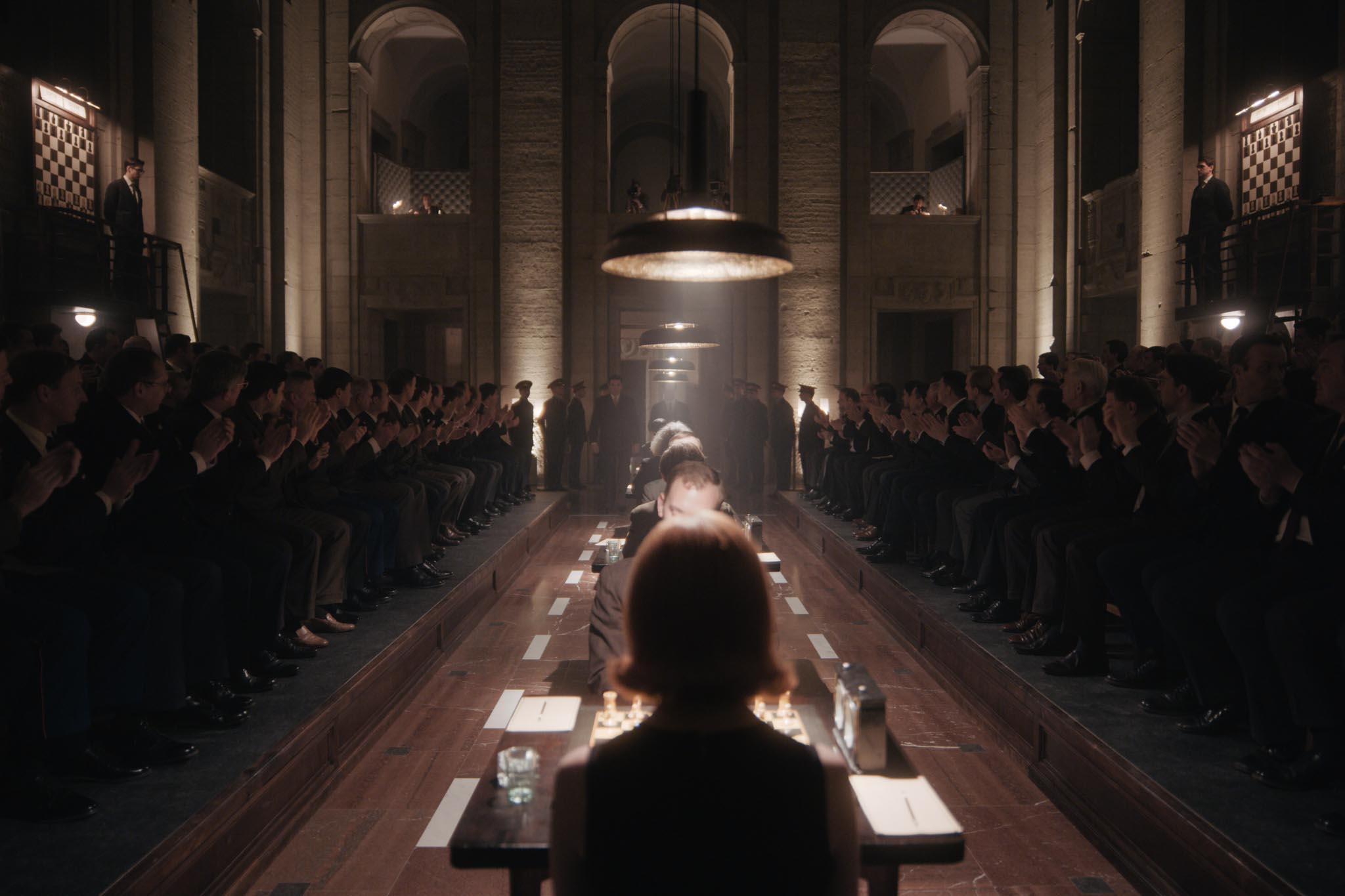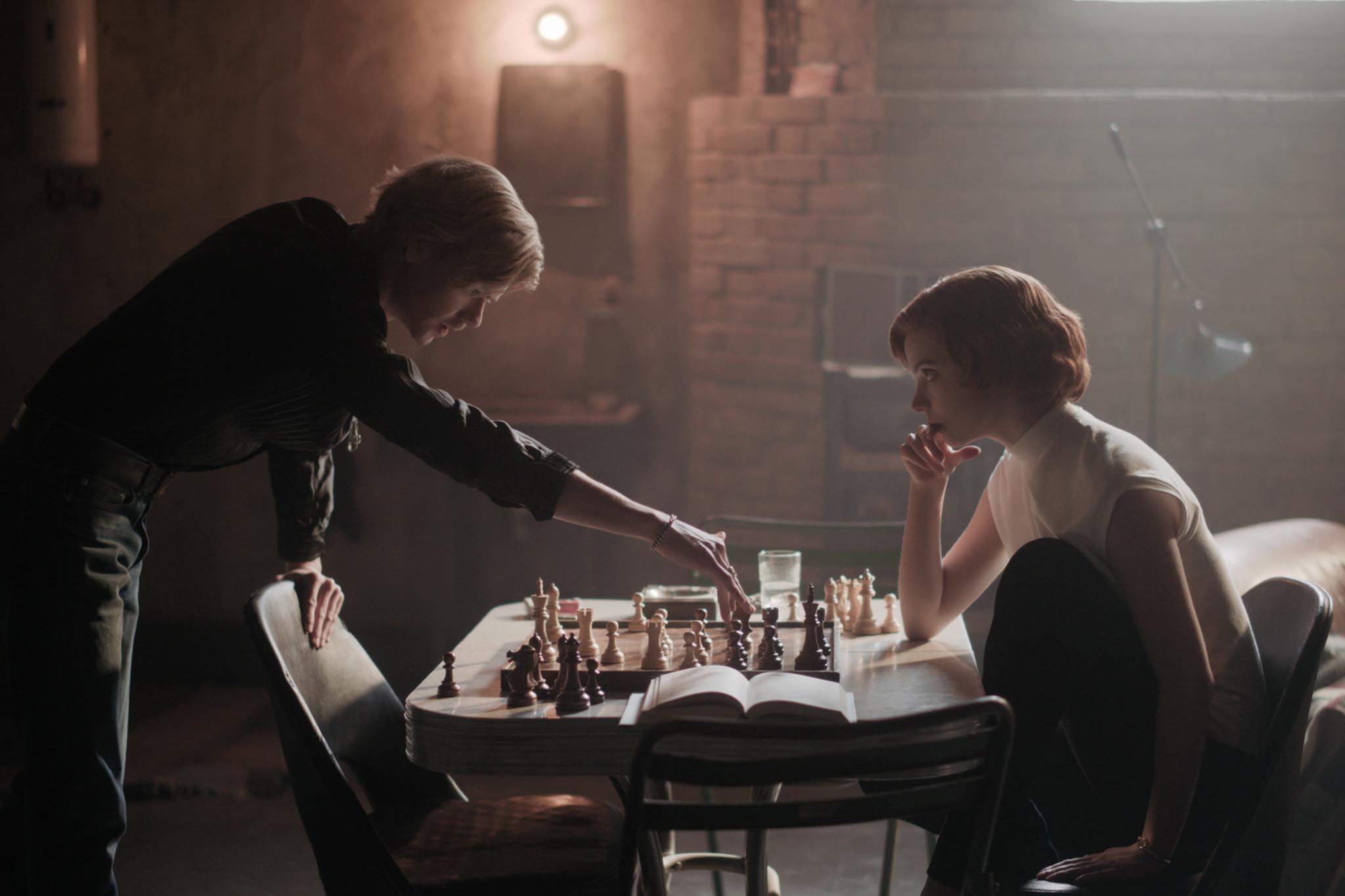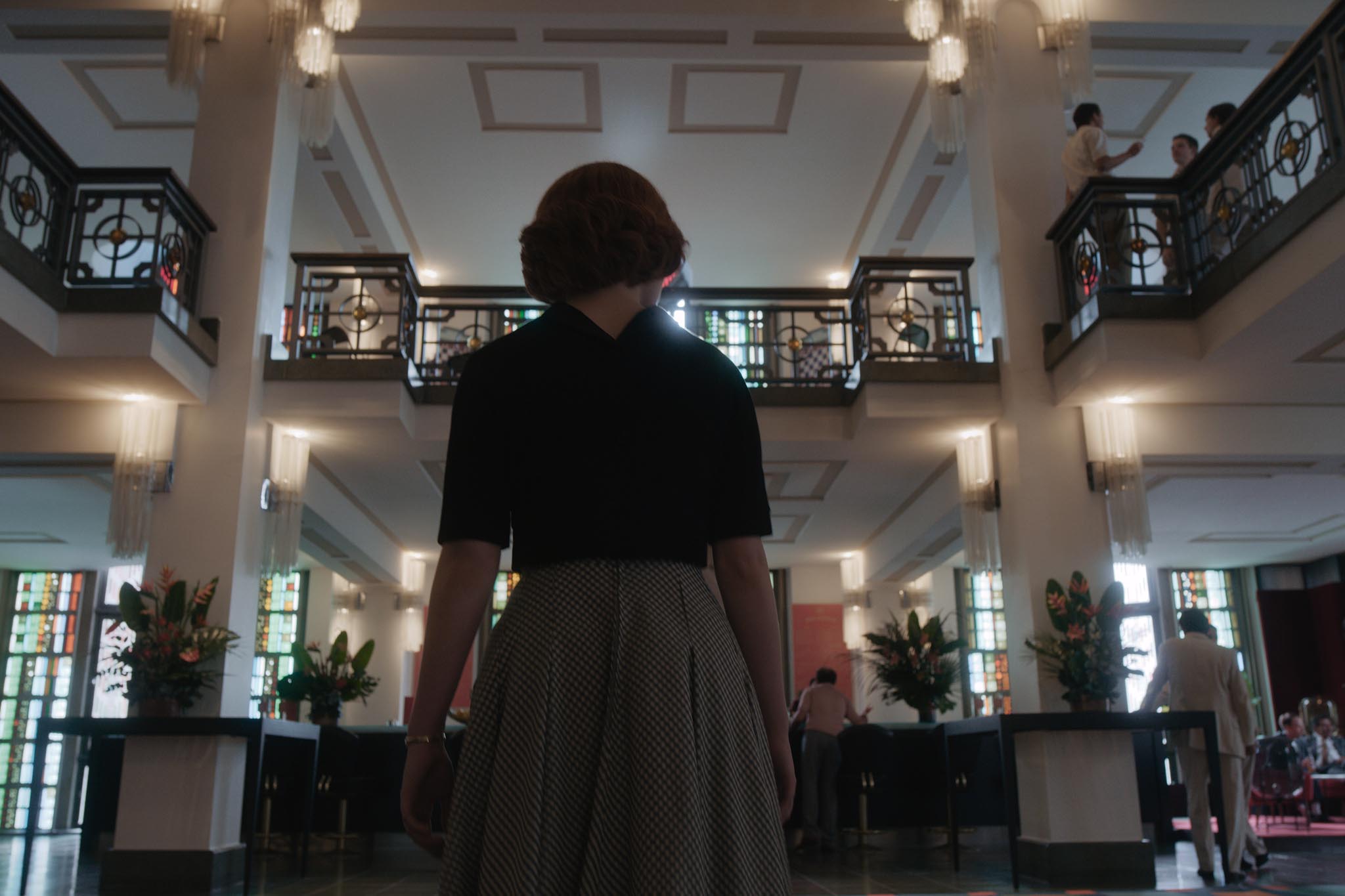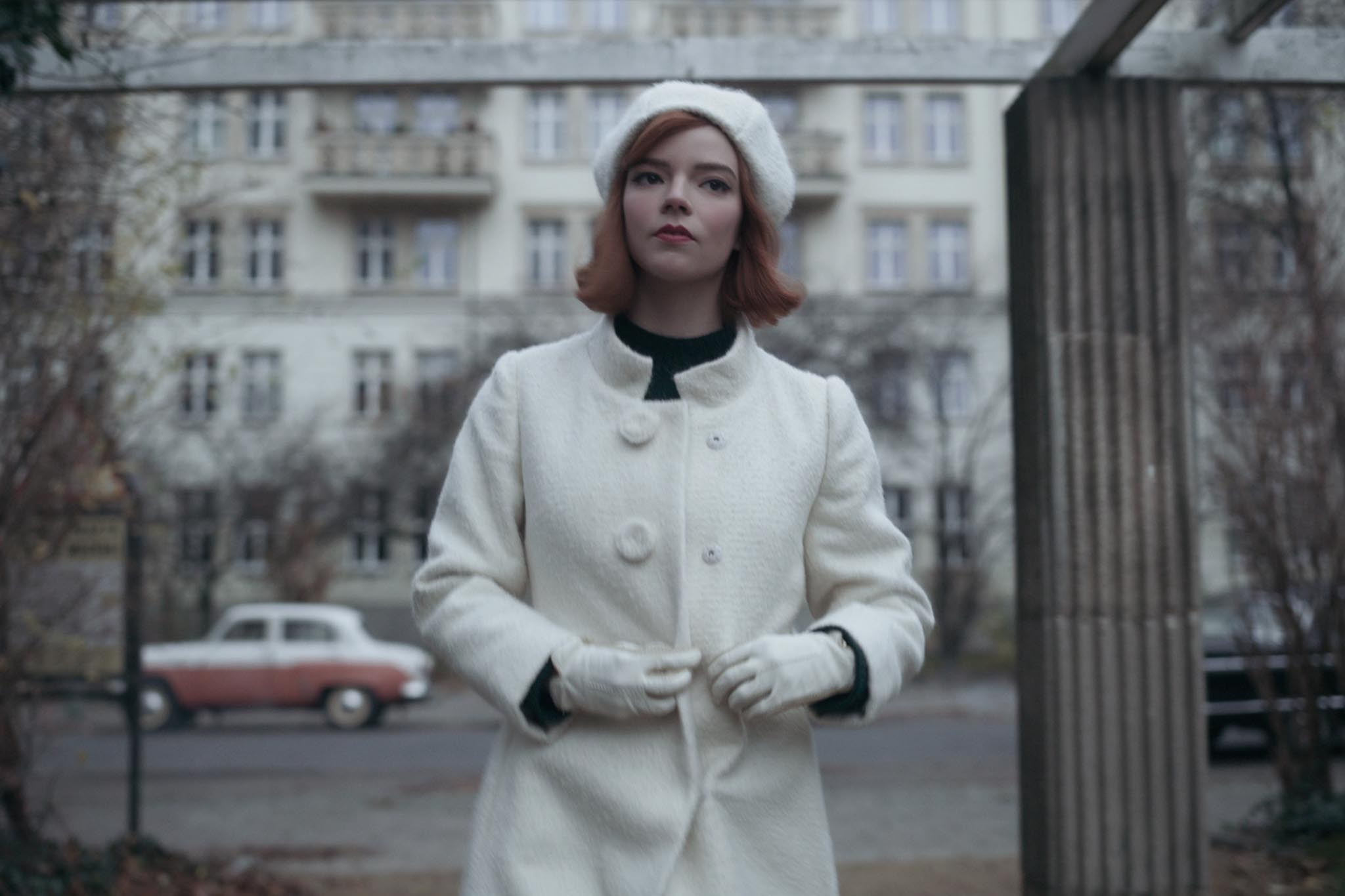In its initial month of streaming, The Queen’s Gambit was viewed by 62 million households. These are Netflix numbers.
Director Scott Frank has brought so much excitement to a story about chess and a conflicted prodigy that the New York Times headlined Marie Fazio’s review with “The Netflix show has reignited interest in the game and fueled demand for chess sets, accessories and timers.” Reviews were quick to extoll the beautifully lit and masterfully composed cinematography of Steven Meizler.
And so—
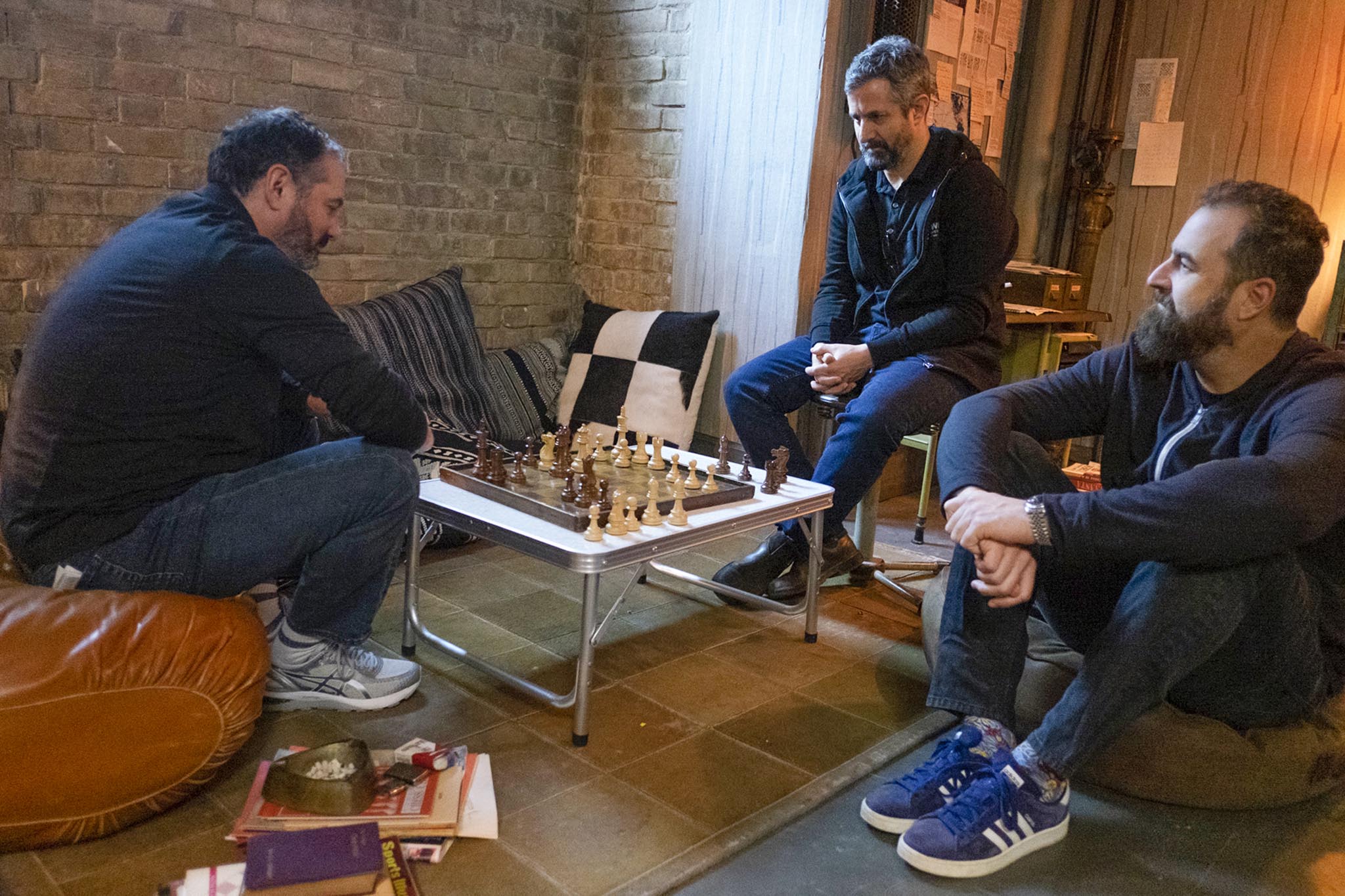
L-R: Director Scott Frank and Steven Meizler playing chess while First AC Richie Masino observes. Photo: Phil Bray. Netflix © 2020.
Jon Fauer: Everyone has been asking what you did to make The Queen’s Gambit look so great. I hope we’ll find out in this discussion. When and where did you start shooting?”
Steven Meizler: We shot mostly in Berlin. The exteriors for Lexington, Kentucky and suburbs were in Toronto and its surroundings. Everything else was in Berlin. We started prep and location scouting in May 2019. Then we started shooting in August: Toronto first and then we moved to Berlin from September to the end of 2109. It was an 81-day schedule.
What cameras did you use?
RED RANGER MONSTRO with the MONSTRO 8K VV sensor. We rented from Camera Ludwig in Berlin. Gareth Daley flew in from London and was there for prep and during the first week of shooting, just to make sure all the assistants and I were up to speed with the RANGER.
I actually had never used the RANGER before. I had always used the DSMC2 as our main cameras. I knew that the RANGER was a little bit more stable than the DSMC2 and also, it’s quieter. I mainly used it for sound reasons. I like the size of the DSMC2 but I think the RANGER may be a little easier for assistants, especially attaching accessories. Having been an assistant myself I know how important that is.
I remember you were the first “God of Focus” in a Film and Digital Times article by Howard Preston for Issue 6 in June 2006. You were featured in a photo chasing after a Citroën DS on “Munich” with a wireless focus system.
Howard was describing the virtues of his new Hand Unit 3: “The most sought-after focus pullers have such highly trained eye-hand coordination and distance judgment that they know exactly how much throw of the focus knob corresponds to the distance they’re observing. For these gods of focus, the ergonomics of the knob, its size, feel, precision, and repeatability are key to doing their magic. For those lacking such precisely calibrated wrists, design innovations and technology can help the merely mortal keep their eyes on the action while maintaining awareness of the lens setting.”
But I digress. You traded in your Preston FIZ and Hand Unit for RED cameras as a DP a while ago. Do you prefer the RED DSMC2 modular style compared to the sort of SUV style of the RANGER?
As a camera assistant working with Steven Soderbergh for so many years, he was always looking for the smallest camera. That was one of the things that drew him to RED. We both learned it well and I enjoyed the modularity of the small camera. Using it as a DP in hand-held situations is especially helpful.
As a DP, I like to operate. You can get into tight spaces and cars and places that you really can’t get to with other cameras. I know that ARRI has the Mini that’s pretty similar in size and the Sony VENICE detaches head from body. Other cameras have kind of caught up, but in the beginning, it was RED leading the way.
When RANGER first came out, I asked Jarred Land why they designed a camera much bigger than DSMC2. He said that in rental situations, where almost every rental house does things differently, RANGER offered a more uniform and integrated camera body.
True. Even though companies such as Tilta and Wooden Camera make very good accessories, the way cameras are rigged can get mismatched. I think it definitely helped that the RANGER was integrated. It was smart for Red to do that. We rented the RED RANGER from Ludwig Kameraverleih in Berlin. I own a RED DSMC2 (with MONSTRO 8K VV sensor). We used mine for Steadicam and handheld work.
I assume you shot in 8K?
Yes, we shot in 8K REDCODE RAW 5:1 and finished in 4K HDR. Our base ISO was 800. I bumped up some of the low-light scenes to 1200 or 1600, but not a lot.
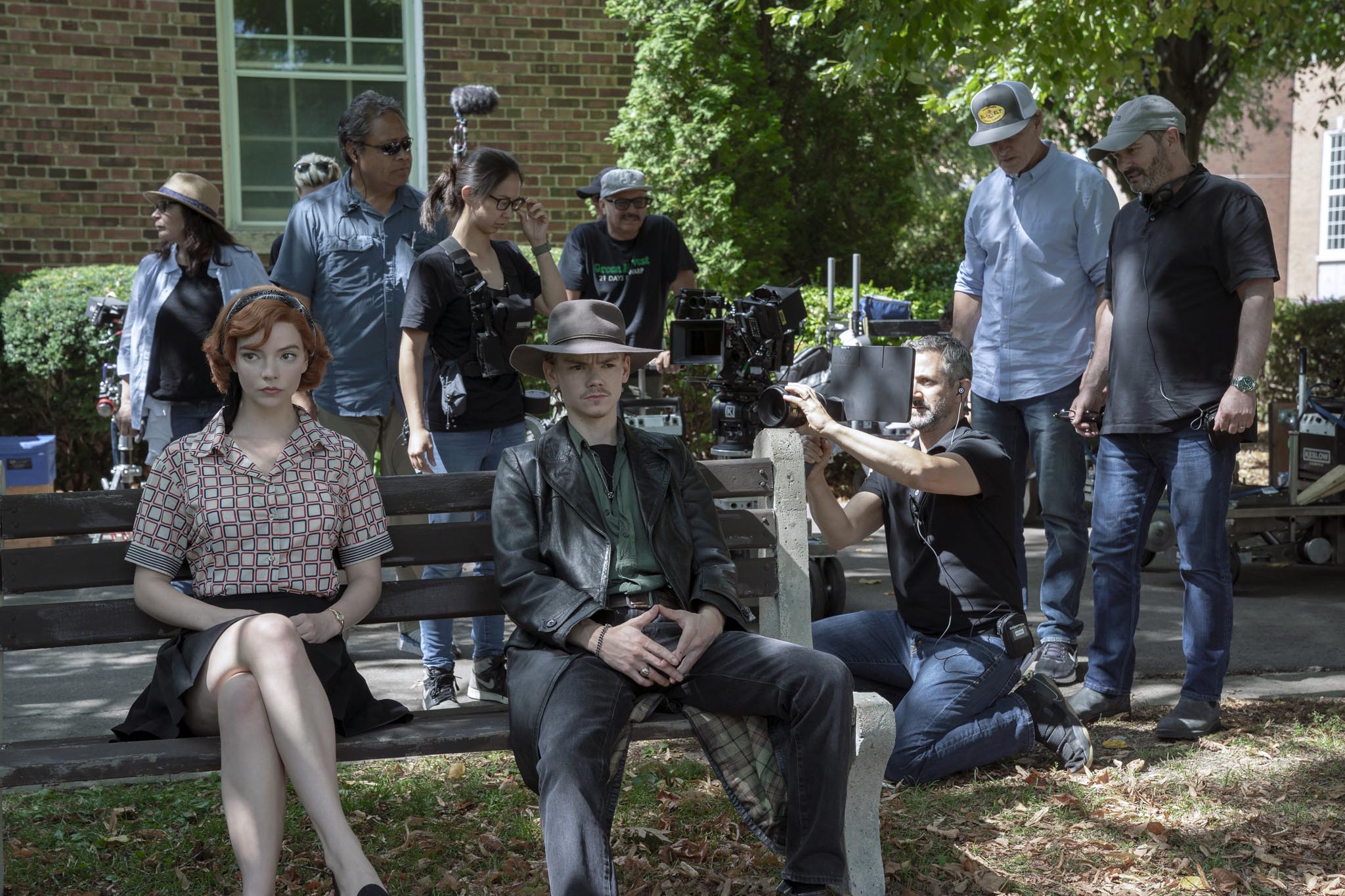
Steven Meizler lining up an 85mm ZEISS Supreme and Chemical Wedding iPad finder on on Anya Taylor-Joy as Beth Harmon and Thomas Brodie-Sangster as Benny in episode 104. Director/Writer/Exec. Producer Scott Frank at right. Photo: Ken Woroner. Netflix © 2020.
What lenses did you have?
We shot with ZEISS Supreme Primes, which I found really great. I had a Tiffen Black Satin 1 diffusion filter in front. I really like the ZEISS Supremes. I usually like a “smoother” lens, which it is. Working with Janusz Kaminski for many years, I appreciated that he was usually using ZEISS Ultra Primes and Super Speeds. I always loved the smoothness of those. I also like the small size of those lenses, especially the Super Speeds (80mm front diameter). I used Super Speeds on Godless.
But the Supremes are Full Frame, which is the format of The Queen’s Gambit. The Supremes are sharp, skin tones are smooth, but it’s the focus fall off that I really love—the softness of the focus as it falls off a face, especially when you rack to another person. Even though the Supremes are incredibly sharp, like on the actor’s eye, they still have a really pleasing quality. The Black Satin filter on top of that was really nice for skin tones and highlights on faces.
I was guessing by the look of The Queen’s Gambit that you were using ZEISS Radiance Primes.
No, they were ZEISS Supremes. You just have to really look into the light. You have to find the flare, it’s always there. When you find the flare, it’s really great. If it’s not there, you have to light until you get more light intensity into the lens. You just go bolder.
Were you shooting wide open in those night interiors?
Yes, I was at T1.5 most of the time in those shots. I did tests with my gaffer Sascha Wolfram, who is a fantastic gaffer in Berlin. We tested with the Supremes wide open at T1.5, and then at T2.8. To be able to shoot at T1.5 and to really get that quality of light and darkness is a very beautiful thing. You don’t get the same beautiful look at T2.8 and the falloff is different. It doesn’t feel lit at maximum aperture.
For the closeups, was there a particular focal length you preferred or were you changing it up?
I liked the 35mm and the 25mm. One of the reasons we were using Large Format was to get very close to the chess board without having distortion.
If we were shooting Super35, the equivalent would have been an 18mm ZEISS Super Speed and it would look a lot different. Not having that distortion was a big part of it. Also, one of the reasons for going to Berlin, was that we were leaning toward German expressionism. For example, in the first episode, seeing the chess board on the ceiling, playing with light and shadows, elevates the scene. I have always been a big fan of The Cabinet of Dr. Caligari.
Did you have all the Supreme focal lengths on The Queen’s Gambit?
We had the 21, 25, 29, 35, 50, 85, 100, 135 mm ZEISS Supreme Primes. I got the 21mm about halfway through the show.
We also had the Angenieux Optimo Ultra 12x Zoom for a few zoom shots. One of these, in episode 7, begins close up on Beth at a theater and zooms out to see Borgov watching from the back. I had a T4.2 on the Optimo, so I shot at 2000 ISO. There is a little grain, but it’s not displeasing. I was happy that we were able to get that shot with the lens in such a low-light environment. I also have to give credit to the music; it also helps make the chess exciting.
You had nice gentle glows in the highlights.
The halation around lights is not as extreme as with Classic Soft or Double Fog filters, which have such an extreme halation around practicals. For example, in Mr. Shaibel’s basement office, we see the bare bulb in the shot. I enjoyed how the Supremes reacted—I could shoot directly into that bright bulb. It was the main source of light. I had some additional lights in the background to lighten the shadows, but the actors were essentially lit with that one light bulb. We had a string system so I could pull the light bulb in different directions to keep the light behind them.
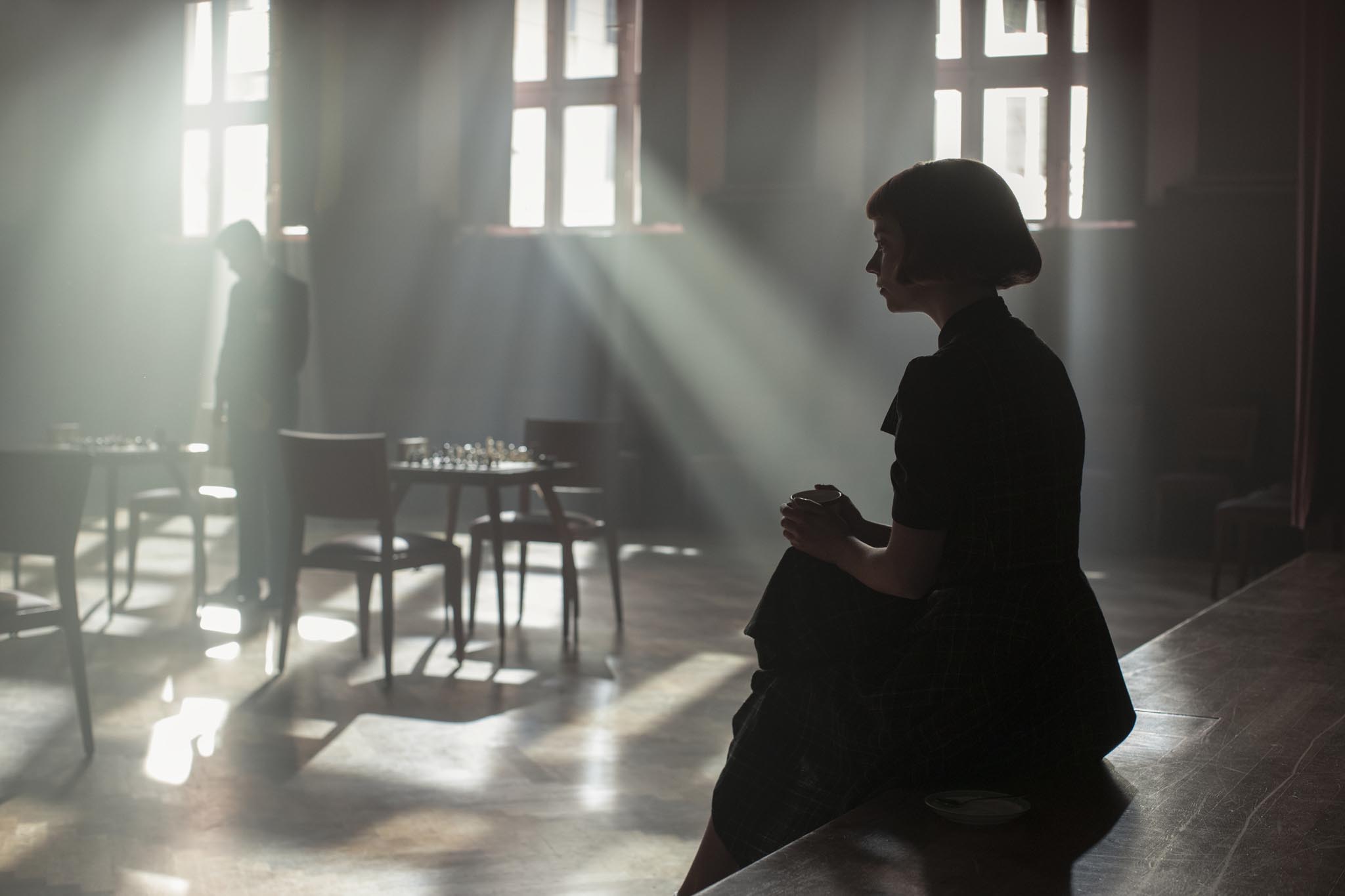
“It would have be a shame not to have smoke inside,” said Steven Meizler.
Anya Taylor-Joy in episode 103. Photo: Phil Bray. Netflix © 2020.
Did you have smoke in that shot and other scenes?
I used a lot of smoke. Shooting in these huge chess halls, with such big windows and lights outside on Condors, it would be a shame not to have smoke inside.
Perhaps that is among the many compelling reasons you were nominated for a BSC Best Cinematography in a TV Drama Award. What more could one want? Bare light bulbs, lots of smoke, big windows. Seriously, your nomination is truly well-deserved.
Well, that’s it. Working for Janusz for many years, in addition to ZEISS lenses, he used smoke so often. It was always about the smoke and backlight. It’s a key to success.
It worked really well. The interesting thing about the light bulb was that it did not totally burn out. You could still see the color in it.
I was amazed by the latitude of the camera and surprised that it didn’t just blow out; you could even see the definition of the tip of the bulb. I would give that credit to the MONSTRO sensor.
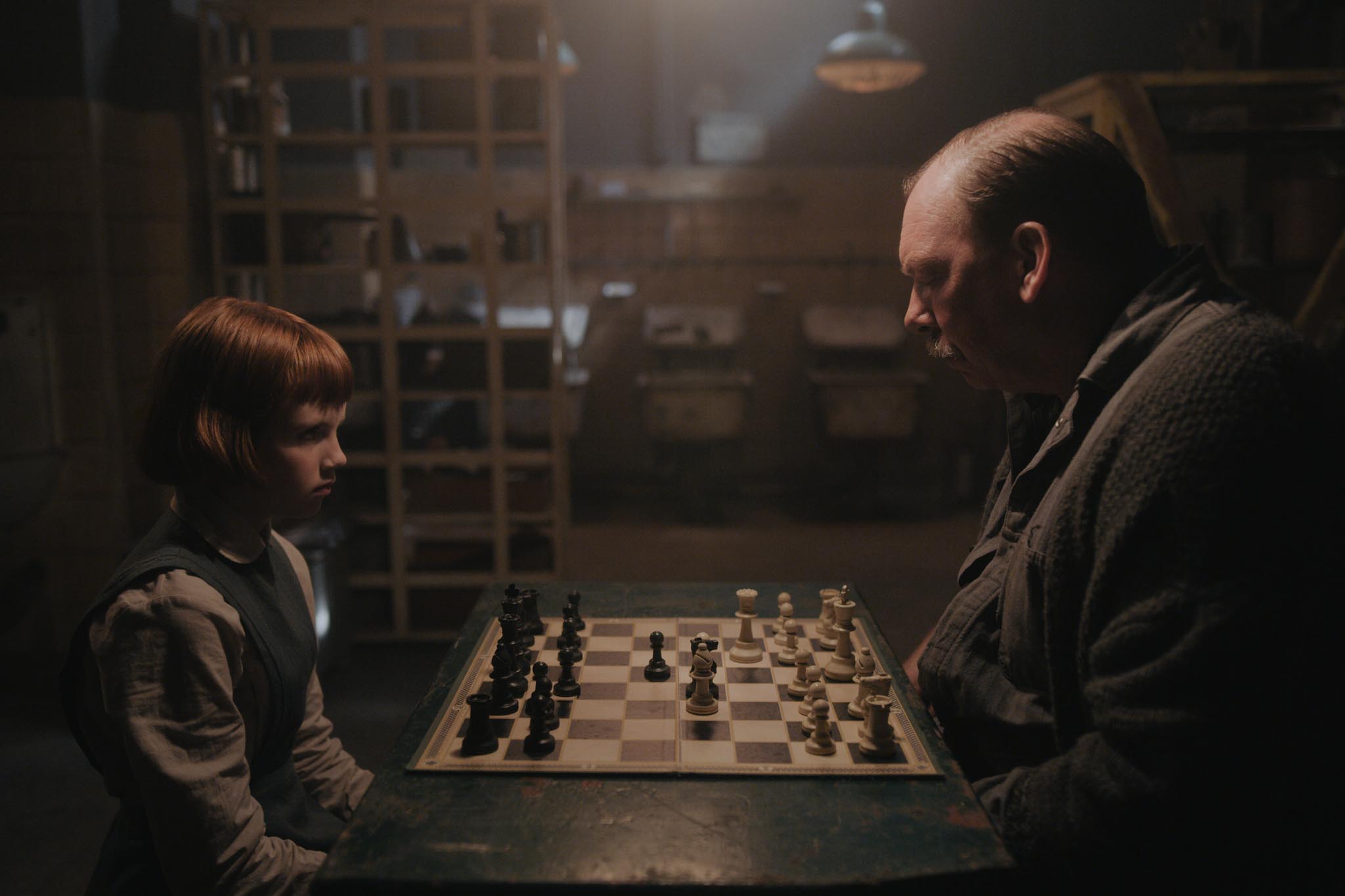
Framegrab from Episode 101 in the orphanage: Isla Johnston as young Beth and Bill Camp as Mr. Shaibel. Netflix © 2020.
Did you establish a viewing LUT while you were shooting?
I don’t work with a DIT on set. And I don’t like to work with a LUT. I operate myself, so I’m used to the camera’s 7-inch monitor and using the histogram on the monitor to know where I’m clipping highlights and seeing shadow detail at the low end.
Having graded HDR a lot, and especially on windows that are very hot, I know what information I’m going to retain and what I’m not going to have. Not having a LUT requires exposing properly, truly having all the information in there and then being able to do what you need to do in post.
That leads into the beginning of prep where my look begins to develop. I like to bring the actual camera, which is also why I like the RED DSMC2—because I use it as if it were a still camera—with two GDU (Global Dynamics United) wood handles from Jarred’s company and a 7-inch monitor on top. I bring all the lenses with me to each location when we’re scouting. Then, I go to Light Iron and start setting up a look with the colorist. To even go further, sometimes I’ll go to location and since I know REDCINE-X PRO, I’ll start grading it myself at night.
I feel that every second of production time should be spent on production and filming the actors rather than sitting in a DIT tent and grading because all that can be done later. It’s like knowing your film stock. I’m treating the files as a film negative; I know where my information is and I know the camera. That’s part of the craft.
Of course, you need to have the trust of the director. It was a great collaboration with Scott Frank. He can really concentrate on the performance and he knows that I’m going to have his back when it comes to keeping the visual language consistent.
When you scout with your DSMC2 and grade during pre-production, I guess you are using the M as in Motion and not the S as in Stills letters in the camera’s name?
Yes. I’m shooting video. I often grab stills and send them out as location guides for the production designer, location managers and others who are so key to the success of the show. I like to block the shots in advance so we can be more efficient when we arrive and also to develop the visual language of the project for myself and the director. I block out scenes to feel what we’re going for. We’re not going there on the day and then trying to figure it out without having a plan. This also allows the director and me to sometimes go off plan. I’m afraid there’s not a lot said about that sometimes.
I’m not trying to flatter or embarrass you, but many colleagues have said that The Queen’s Gambit looked better than anything else shot with Supremes. Why is that?
I think it’s a combination. I have to give a lot of credit to the production designer Uli Hanisch and costume designer Gabriele Binder. I have to say Sascha got me into using a lot of negative fill; I hadn’t used negative fill to such an extreme before and I think it helped in the blacks. I also want to say that the light in Berlin was amazing. We were shooting in the fall and the days were not long. But when the sun came out, it was always at a low angle in the sky.
Also contributing were those beautiful chess halls, being able to shoot low angle toward beautiful wide ceilings and to feel the space. I think all of those things added to it.
Where was the Mexican hotel location?
That was in Berlin. It was the lobby of a ballet theater. The art department added colors to the windows and pattern designs in between. It was a big task but helped because we did not want to see Berlin outside because it was supposed to be Mexico City. We adhered to a strict color palette going from the ward to the Wheatley house, to the Gibson hotel (Cincinnati), to Mexico City, to Las Vegas, to Paris and finally Moscow.
Was the opening scene in the Paris hotel also Berlin: she oversleeps, they knock on the door, she runs through the hotel?
That was in Berlin. I want to give credit to George Billinger and Christian Scheibe. George was the Steadicam and B camera operator and also our invaluable second unit DP. Christian was our key grip/ dolly grip. George was on a rickshaw with a Steadicam for those shots.
Did you bring a lot of crew with you from the US?
Just George and Richie Masino as First Camera Assistant.
Which brings us back to Howard Preston. I assume you must have used a Light Ranger, wide open, T1.5, Full Frame, depth of field less than a Queen chess piece?
It’s definitely challenging. Richie used the Light Ranger 2, which is an amazing device.
The show was exciting. Most people didn’t think they would get excited by chess, but we were all on the edge of our seats watching it.
I think a lot of that had to do with the idea that we were showing it so much through Beth’s perspective. Anya, as Beth, was incredible. Because we were with her so much, you have a singularity of vision, but you can change up the language for each tournament and still have a cohesiveness to it. What made it interesting was staying with her; she’s the one constant throughout.
How did you light the big, wide shot in the final tournament scene?
We lit it very sparsely. It’s a really big ceiling and I had some uplights for the corridors. I let the audience fall off and mainly used the source of the practical light bulbs to be the main source of lighting.
The early chess match in Cincinnati had a lot of light coming in from outside.
That was three 18 Ks coming in from outside the window. It was a location in Berlin, part of the sound studio where David Bowie recorded “Heroes.”
There were interesting extreme closeups on the chess board with Beth behind it. Did you use diopters?
No, the Supremes focus very close. That was nice. And the Full Frame format allowed us to get a little closer and still have the view of it without our being actually as close as you would need for regular format. Our aspect ratio was 1.78:1, by the way.
You had a long period of prep, were the only DP, with only one director, for 7 episodes and a shooting schedule longer than most features.
The Queen’s Gambit was three months prep and 90 days of shooting. To be able to find all the locations, to storyboard with the director and production designer, to build the sets—you need to have everything planned like it’s one long movie.
I wish that TV and streaming would head more to that model. I see quality shows that have multiple directors and they just lose the vision that is unified and a look that’s cohesive. If they don’t have one director going through and they want different DPs, you just lose it. The projects that are succeeding have one director and one DP doing the whole thing. Scott Frank wrote and directed all the episodes.
Is this the new normal?
Yes. I think The Queen’s Gambit benefited from being seven episodes rather than being a two hour movie. Many people have tried to get this movie off as a movie; Bertolucci wanted it, and many people were involved in trying to get it. Scott was very smart wanting to do it as a limited series.
I guess Netflix deserves a lot of credit for allowing you to do it this way?
They did. It wasn’t a cheap electric budget and it wasn’t a cheap art department and costume budget. I truly appreciate how Netflix supported us.
Did RED RANGER and the DSMC2 match completely?
Yes. They have the same sensor. Incidentally, that same chip is also in the Panavision DXL2. The DXL2 has Light Iron’s color science baked in. But since I use Light Iron, that color science is available to me in post-production.
How did you do the grading?
We started grading in May or June of 2020 at Light Iron, New York. Steven Bodner was our colorist. It was strange because we had to start by doing it remotely from home with iPad pros. That was a little tricky in itself. I eventually got to see it on a Sony X300 4K OLED monitor at Light Iron Los Angeles in a sealed-off room. We had remote sessions of all the episodes with Scott Frank, our director; Michelle Tesoro, the editor; and Steven Bodner grading from his home—all in New York—and me in LA.
So you were grading at the height of the pandemic?
Yes. We also were doing a lot of Zoom meetings before grading, going over VFX shots that included our production designer, Uli Hanisch and the VFX supervisor, John Mangia. We viewed with iPad Pros for about three weeks and then about two weeks at Light Iron in LA where I went through each episode.
How did you get into the film business?
I grew up in Boston. I studied film at University of Rochester. A classmate of mine was Kramer Morgenthau. We’re friends and actually knew each other then. There were only 13 film studies majors in our class. It was mostly film theory and criticism, which I loved. I drove to LA after college and started working as a receptionist and then a PA at Roger Corman’s company. Then I got involved with their cameras: they had an Arriflex 35BL-4 and a Mitchell BNC. That’s where I met Janusz.
Roger Corman launched dozens of successful careers.
I worked with many amazing DPs and it was a really creative time there in the early nineties. It was even better than a film school. When Janusz started getting offers for bigger films and took me with him, things went from there. I feel very fortunate that I was there at that time.
And here you are with The Queen’s Gambit and widespread praise for how gorgeous it looked. Congratulations.
This is a “reprint” from March 2021 Issue 107 FDTimes.

